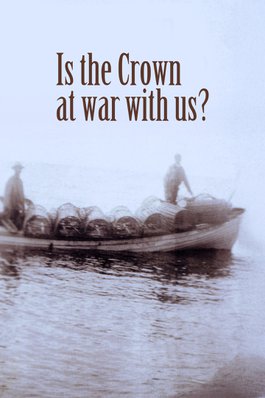Is the Crown at war with us?
In this feature-length documentary by Alanis Obomsawin, it's the summer of 2000 and the country watches in disbelief as federal fisheries wage war on the Mi'kmaq fishermen of Burnt Church, New Brunswick. Why would officials of the Canadian government attack citizens for exercising rights that had been affirmed by the highest court in the land? Casting her cinematic and intellectual nets into history to provide context, Obomsawin delineates the complex roots of the conflict with passion and clarity, building a persuasive defence of the Mi'kmaq position.
In this feature-length documentary by Alanis Obomsawin, it's the summer of 2000 and the country watches in disbelief as federal fisheries wage war on the Mi'kmaq fishermen of Burnt Church, New Brunswick. Why would officials of the Canadian government attack citizens for exercising rights that had been affirmed by the highest court in the land? Casting her cinematic and intellectual nets into history to provide context, Obomsawin delineates the complex roots of the conflict with passion and clarity, building a persuasive defence of the Mi'kmaq position.
-
original music composerFrancis Grandmont
-
writerAlanis Obomsawin
-
directorAlanis Obomsawin
-
editorAlison Burns
-
cameraPhilippe AmiguetYoan CartMichel La Veaux
-
location soundRaymond MarcouxIsmaël Cordeiro
-
musicianFrancis GrandmontNormand GuilbeaultEloi PainchaudNadine Turbide
-
assistant cameraSébastien CassouGeoffroy St-HilairePhilippe Martel
-
sound editorAndré Chaput
-
photo animationMeilan Lam
-
production assistantWayne DedamBurdett VicaireWendell Metallic
-
sound technicianBiagio Pagano
-
digital editing technicianDanielle Raymond
-
voice recordingPatrick Knup
-
voice recording directorClaude Dionne
-
voiceArthur HoldenTony Robinow
-
narrationAlanis Obomsawin
-
drawingsSgoagani
-
transcriptionTyson Phillips
-
stills photographerPamela MitchellJean BartibogueTina Young
-
researchAlanis Obomsawin
-
animation cameraPierre Landry
-
post-production coordinatorClaude CardinalLinda Payette
-
underwater imagesChris Harvey-Clark
-
amateur video cameraChristian Peacemaker TeamsMark SimonGeronimo SomervilleAboriginal Rights CoalitionJudy LooClinton Sorbey
-
music recordingGeoffrey MitchellSylvain Cajelais
-
re-recording mixerSerge BoivinJean Paul Vialard
-
sound post production technicianDaniel TrépanierPatrick Viegas
-
titlesGaspard GaudreauLouise Overy
-
on-line technicianDenis Pilon
-
digital video to film transferGaspard Gaudreau
-
production administration assistantChristine Williams
-
translatorWendell MetallicGkisedtanamook
-
program administratorMarie Tonto-DonatiNickie Merulla
-
producerAlanis Obomsawin
-
executive producerSally Bochner
Pre-teach the various disputes that have occurred between Indigenous peoples and the government historically, especially regarding land and fishing rights. A good companion film to this one is Incident at Restigouche, which explores similar confrontations with the law. Have students compare and contrast the similarities and differences between the two incidents. Discuss the government’s justification for their actions. After viewing both films, conduct a full discussion around Aboriginal rights.
More educational content
Is the Crown at war with us?, Alanis Obomsawin, provided by the National Film Board of Canada
